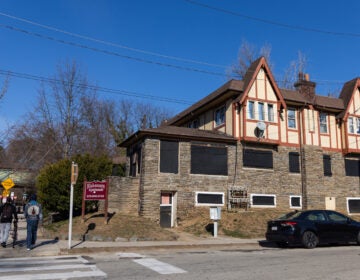Redeveloping the Redevelopment Authority

It has been a long, turbulent run for the Philadelphia Redevelopment Authority.
Five executive directors in eight years. Dramatically slowed sales of publicly owned property.
And embarrassing worldwide coverage (literally) of the agency’s ill-advised tussle with developer Ori Feibush over his unauthorized makeover of an unkempt agency-owned lot in Point Breeze.
Before they can get better, the agency’s fortunes are likely to get worse.
The authority, with 80 staff members, is bracing for a round of layoffs this summer, perhaps a big one. On top of that, the city is moving, albeit slower than advocates would like, to create a new land bank. Right now, it looks as though the land bank – an entity that would house most if not all publicly owned land and have the power to acquire tax delinquent parcels – would be housed outside of PRA. That has some in the city’s redevelopment community wondering what, exactly, PRA will do in the future.
With the power of eminent domain, huge holdings of vacant land and a staff with deep technical expertise, the authority is likely to remain a vital tool in the city’s fight to redevelop blighted neighborhoods and fuel economic growth.
But the last few years have nonetheless raised serious questions about PRA’s role and its future, as its new executive director acknowledges.
“We need to make the authority relevant again. We need to stabilize ourselves financially. We need to stabilize our morale. And we need to stabilize our employee structure,” said Brian Abernathy, who was named interim executive director of the PRA in March, after Ed Covington abruptly stepped down.
And yet Abernathy said the Authority was in better shape than it might appear from the outside, having made some critically important internal reforms in recent years.
“We’ve come a long way in a relatively short period of time. We’ve moving in the right direction,” Abernathy said, praising his predecessors for “recognizing some of the administrative problems the authority faces and correcting them.”
Those behind the scenes improvements include new financial and property tracking systems, an overhauled disposition policy, and the opening of the Front Door, a unified entry point for developers, non-profits and average residents interested in buying city-owned land.
Prior to the Nutter administration, the Redevelopment Authority operated in an opaque and sometimes unorthodox manner. Record keeping was sloppy (the PRA did not even have a complete list of the properties it owned), political bosses had used the agency as a patronage haven and the perception was that would-be buyers needed political connections to get a deal done.
Much of that has changed for the better since Mayor Nutter took office. But by one critical measure – the disposition of city owned land, which includes many PRA properties – the agency’s performance has declined dramatically in recent years, upsetting both redevelopment advocates and members of City Council.
“Our reputation with City Council is less than stellar. Our reputation with the administration is less than stellar. It’s been a bit tarnished and we need to prove we can function well, that we’re competent, and that we’re responsive to their needs,” Abernathy said.
While Abernathy is still finding his footing at PRA, he did identify a few early changes that are in the works or on his early agenda.
Budget cuts
The federal budget sequestration is expected to drain $13.8 million from Pennsylvania’s 2013 allotment in Community Development Block Grant funding, an important revenue source for the Redevelopment Authority (as well as other city agencies). That hit, on top or earlier CDBG cuts, will force PRA to lay off staff, Abernathy said.
“We’ve had an operating deficit for a number of years. We’ve made that up by working through what we’ve called working capital, and that’s masked how bad the problem is,” Abernathy said. “I don’t think the authority can or should continue to spend down those funds to maintain our administrative costs.”
Just how much will be trimmed from the Redevelopment Authority $12.28 million 2012-2013 budget is unclear, Abernathy said, but layoffs seem unavoidable.
Improved relations with City Council
Abernathy, who was a senior aide to retired Councilman Frank DiCicco before joining the Nutter administration, said “rebuilding bridges between us and individual council members is very important to me.” This would appear to mark a real departure from earlier years, particularly when the agency was run by Terry Gillen, who labored to depoliticize the PRA. Abernathy seems to be taking a more pragmatic approach, in light of council’s ability to veto all meaningful PRA transactions. “For better or worse we need City Council to move these things, and there’s nothing wrong with partnering with council,” Abernathy said.
Tweaks to the Front Door
“There have been some valid concerns about how the front door is operating,” Abernathy said. “It’s a top priority to have those concerns resolved by summer. Some are tweaks to policy, most of them are about internal operations.”
Abernathy declined to elaborate, but it is clear that the Front Door has so far failed to accelerate the sale of city owned land in a meaningful way. In the year since the Front Door launched, the pace of sales of city owned land has not picked up, despite a steady rate of “expressions of interest” in available properties from would-be buyers.
Disposition Philosophy
Early in the Nutter administration, the Redevelopment Authority shifted priorities, becoming more reluctant to give publicly owned land away or to sell it at deep discount and more interested in getting full market value for the parcels. One apparent side effect of that change was a slowdown in sales, a development that angered council members and community groups anxious to see the city’s 10,000 vacant lots put back into productive use.
The administration reversed course with its new disposition policy last year, and Abernathy seems fully behind that decision.
“Our job isn’t just to make money. We need to be financially stable, but we’re not a for profit business,” Abernathy said when asked about the use of PRA land near 17th and Carpenter – which has a robust real estate market – for a community park. “Sometimes we’re going to have let key parcels that we could make money on go, in order to meet other administration priorities. Green space is a prime goal. Affordable housing is a prime goal.”
Once this difficult summer has passed, Abernathy wants the PRA to refocus on what he calls its “core mission, which is really redevelopment and housing financing.”
“We have the knowledge base and expertise to assemble large parcels and to finance affordable housing projects,” Abernathy said.
One model, Abernathy said, was the Philadelphia Industrial Development Corporation, the non-profit, public/private organization that has made such massive commercial and industrial projects like the Navy Yard possible.
“There’s no reason the PRA can’t be the PIDC of the residential world,” Abernathy said.
WHYY is your source for fact-based, in-depth journalism and information. As a nonprofit organization, we rely on financial support from readers like you. Please give today.





